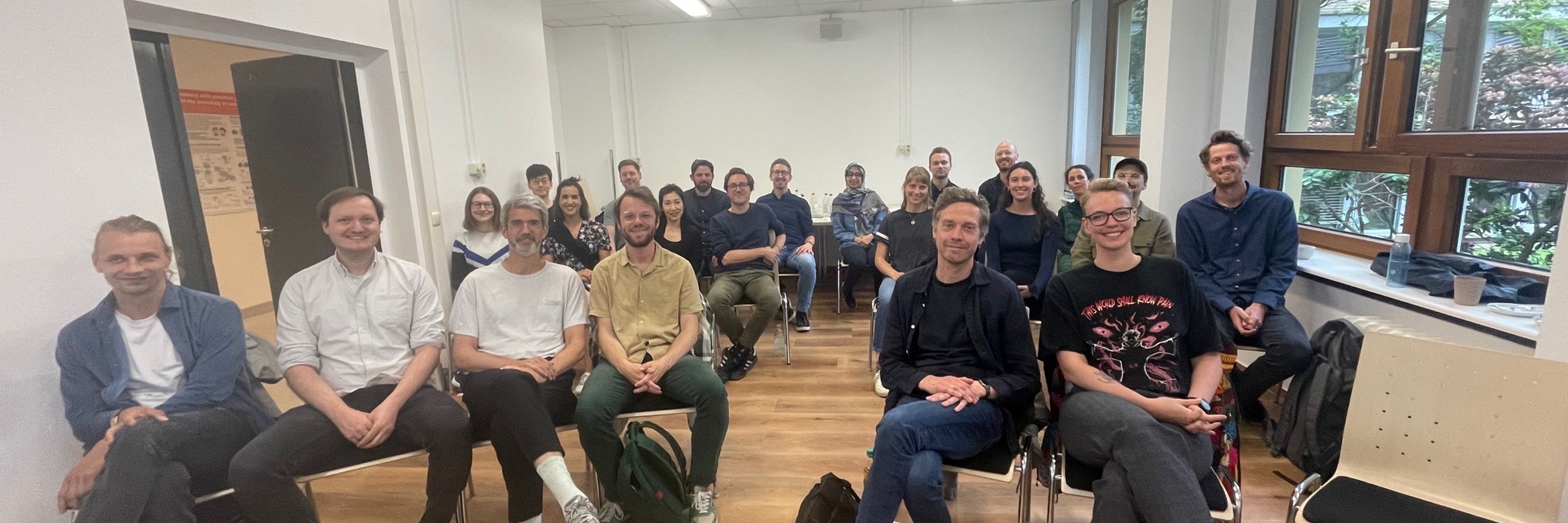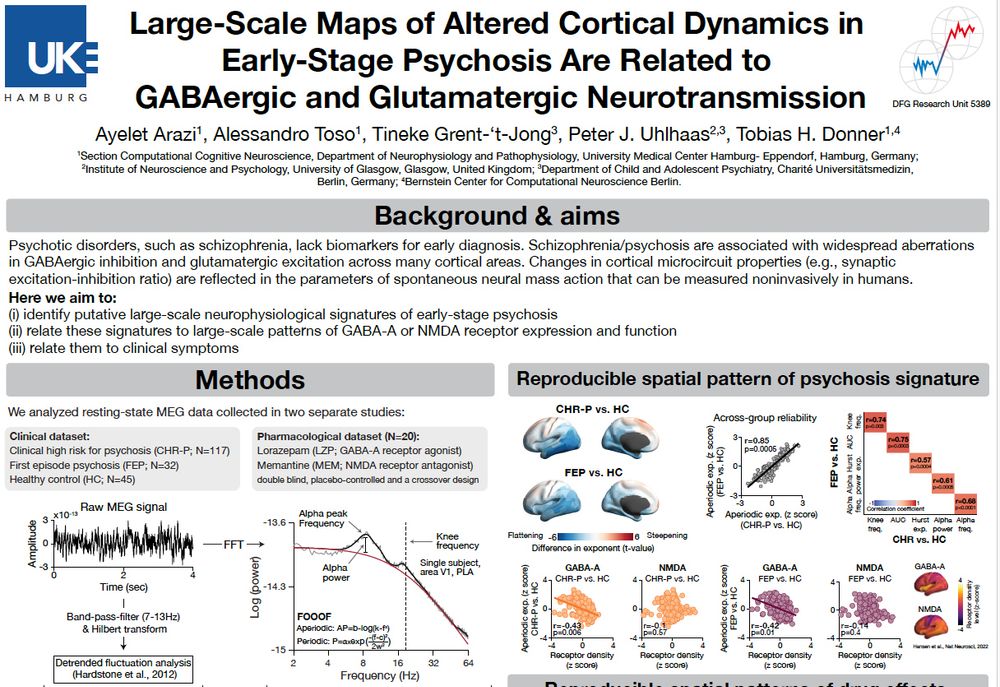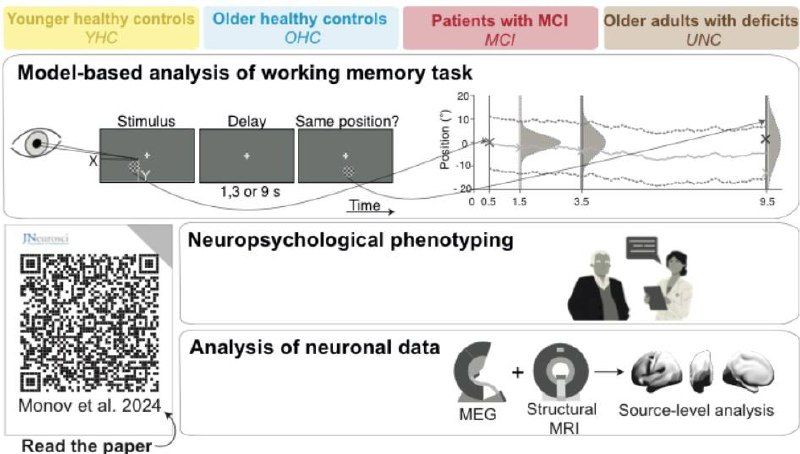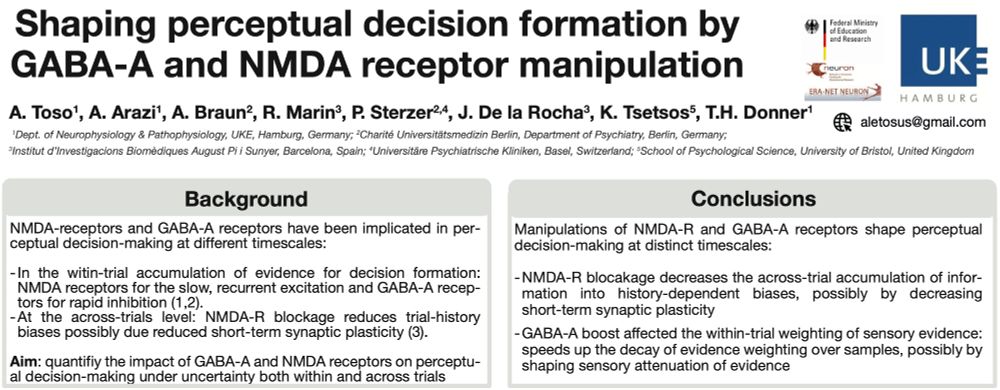
Donner Lab
@donnerlab.bsky.social
The goal of our research is to understand how brain states shape decision-making, and how this process goes awry in certain neurological & psychiatric disorders
| tobiasdonner.net | University Medical Center Hamburg-Eppendorf, Germany
| tobiasdonner.net | University Medical Center Hamburg-Eppendorf, Germany
It fits the behavioral data better than a range of alternatives, and reproduces a number of behavioral and neural signatures, including the concurrently measured dynamics of the encoding of contrast samples in visual cortex.

November 3, 2025 at 9:12 PM
It fits the behavioral data better than a range of alternatives, and reproduces a number of behavioral and neural signatures, including the concurrently measured dynamics of the encoding of contrast samples in visual cortex.
Our model combines sensory adaptation, leaky accumulation with feed-forward inhibition, and an asymmetric readout of the DVs in confidence formation.

November 3, 2025 at 9:12 PM
Our model combines sensory adaptation, leaky accumulation with feed-forward inhibition, and an asymmetric readout of the DVs in confidence formation.
We next used single-trial regression to predict confidence from the winning and losing DVs, controlling for evidence strength. Both DVs made a significant, unique contribution to confidence. However, in contrast to standard models, the magnitude of the winning DV was stronger.

November 3, 2025 at 9:12 PM
We next used single-trial regression to predict confidence from the winning and losing DVs, controlling for evidence strength. Both DVs made a significant, unique contribution to confidence. However, in contrast to standard models, the magnitude of the winning DV was stronger.
Despite the independent inputs, we found intrinsic negative correlations between the two DVs within trials, a signature of inhibition between the sensory-motor pathways supporting the two alternative choices. The strength of this correlation on each trial predicted confidence.

November 3, 2025 at 9:12 PM
Despite the independent inputs, we found intrinsic negative correlations between the two DVs within trials, a signature of inhibition between the sensory-motor pathways supporting the two alternative choices. The strength of this correlation on each trial predicted confidence.
We tracked the competition between neural decision variables (DVs) in the human frontal cortex, combining a novel task with atlas-based multivariate decoding of source-level MEG data to track two neural DVs for alternative choices in left and right premotor/motor cortex (PMd/M1).

November 3, 2025 at 9:12 PM
We tracked the competition between neural decision variables (DVs) in the human frontal cortex, combining a novel task with atlas-based multivariate decoding of source-level MEG data to track two neural DVs for alternative choices in left and right premotor/motor cortex (PMd/M1).
It fits the behavioral data better than a range of alternatives, and reproduces a number of behavioral and neural signatures, including the concurrently measured dynamics of the encoding of contrast samples in visual cortex.

November 3, 2025 at 6:06 PM
It fits the behavioral data better than a range of alternatives, and reproduces a number of behavioral and neural signatures, including the concurrently measured dynamics of the encoding of contrast samples in visual cortex.
Our model combines sensory adaptation, leaky accumulation with feed-forward inhibition, and an asymmetric readout of the DVs in confidence formation.

November 3, 2025 at 6:06 PM
Our model combines sensory adaptation, leaky accumulation with feed-forward inhibition, and an asymmetric readout of the DVs in confidence formation.
We next used single-trial regression to predict confidence from the winning and losing DVs, controlling for evidence strength. Both DVs made a significant, unique contribution to confidence. However, in contrast to standard models, the magnitude of the winning DV was stronger.

November 3, 2025 at 6:06 PM
We next used single-trial regression to predict confidence from the winning and losing DVs, controlling for evidence strength. Both DVs made a significant, unique contribution to confidence. However, in contrast to standard models, the magnitude of the winning DV was stronger.
Despite the independent inputs, we found intrinsic negative correlations between the two DVs within trials, a signature of inhibition between the sensory-motor pathways supporting the two alternative choices. The strength of this correlation on each trial predicted confidence.

November 3, 2025 at 6:06 PM
Despite the independent inputs, we found intrinsic negative correlations between the two DVs within trials, a signature of inhibition between the sensory-motor pathways supporting the two alternative choices. The strength of this correlation on each trial predicted confidence.
We tracked the competition between neural decision variables (DVs) in the human frontal cortex, combining a novel task with atlas-based multivariate decoding of source-level MEG data to track two neural DVs for alternative choices in left and right premotor/motor cortex (PMd/M1).

November 3, 2025 at 6:06 PM
We tracked the competition between neural decision variables (DVs) in the human frontal cortex, combining a novel task with atlas-based multivariate decoding of source-level MEG data to track two neural DVs for alternative choices in left and right premotor/motor cortex (PMd/M1).
It fits the behavioral data better than a range of alternatives, and reproduces a number of behavioral and neural signatures, including the concurrently measured dynamics of the encoding of contrast samples in visual cortex.

November 3, 2025 at 6:01 PM
It fits the behavioral data better than a range of alternatives, and reproduces a number of behavioral and neural signatures, including the concurrently measured dynamics of the encoding of contrast samples in visual cortex.
Our model combines sensory adaptation, leaky accumulation with feed-forward inhibition, and an asymmetric readout of the DVs in confidence formation.

November 3, 2025 at 6:01 PM
Our model combines sensory adaptation, leaky accumulation with feed-forward inhibition, and an asymmetric readout of the DVs in confidence formation.
We next used single-trial regression to predict confidence from the winning and losing DVs, controlling for evidence strength. Both DVs made a significant, unique contribution to confidence. However, in contrast to standard models, the magnitude of the winning DV was stronger.

November 3, 2025 at 6:01 PM
We next used single-trial regression to predict confidence from the winning and losing DVs, controlling for evidence strength. Both DVs made a significant, unique contribution to confidence. However, in contrast to standard models, the magnitude of the winning DV was stronger.
Despite the independent inputs, we found intrinsic negative correlations between the two DVs within trials, a signature of inhibition between the sensory-motor pathways supporting the two alternative choices. The strength of this correlation on each trial predicted confidence.

November 3, 2025 at 6:01 PM
Despite the independent inputs, we found intrinsic negative correlations between the two DVs within trials, a signature of inhibition between the sensory-motor pathways supporting the two alternative choices. The strength of this correlation on each trial predicted confidence.
We tracked the competition between neural decision variables (DVs) in the human frontal cortex, combining a novel task with atlas-based multivariate decoding of source-level MEG data to track two neural DVs for alternative choices in left and right premotor/motor cortex (PMd/M1).

November 3, 2025 at 6:01 PM
We tracked the competition between neural decision variables (DVs) in the human frontal cortex, combining a novel task with atlas-based multivariate decoding of source-level MEG data to track two neural DVs for alternative choices in left and right premotor/motor cortex (PMd/M1).
Ayelet Arazi - 📍 Poster 3.5 | Wed (July 16th):
Cortex-wide changes in neural dynamics in early-stage psychosis relate to GABA-A or NMDA receptor expression and function, and to clinical symptoms.
Cortex-wide changes in neural dynamics in early-stage psychosis relate to GABA-A or NMDA receptor expression and function, and to clinical symptoms.

July 12, 2025 at 2:09 PM
Ayelet Arazi - 📍 Poster 3.5 | Wed (July 16th):
Cortex-wide changes in neural dynamics in early-stage psychosis relate to GABA-A or NMDA receptor expression and function, and to clinical symptoms.
Cortex-wide changes in neural dynamics in early-stage psychosis relate to GABA-A or NMDA receptor expression and function, and to clinical symptoms.
Gina Monov - 📍 Poster 2.13 | Tue (July 15th):
Come explore our latest findings on cortical working memory dynamics in aging and MCI!
Come explore our latest findings on cortical working memory dynamics in aging and MCI!

July 12, 2025 at 2:09 PM
Gina Monov - 📍 Poster 2.13 | Tue (July 15th):
Come explore our latest findings on cortical working memory dynamics in aging and MCI!
Come explore our latest findings on cortical working memory dynamics in aging and MCI!
Alessandro Toso - 📍 Poster 1.4 | Mon (July 14th):
Through pharmacological manipulations in humans, we showed that GABA-A and NMDA receptors shape perceptual decision-making at distinct timescales — within-trial and across-trial, respectively.
Through pharmacological manipulations in humans, we showed that GABA-A and NMDA receptors shape perceptual decision-making at distinct timescales — within-trial and across-trial, respectively.

July 12, 2025 at 2:09 PM
Alessandro Toso - 📍 Poster 1.4 | Mon (July 14th):
Through pharmacological manipulations in humans, we showed that GABA-A and NMDA receptors shape perceptual decision-making at distinct timescales — within-trial and across-trial, respectively.
Through pharmacological manipulations in humans, we showed that GABA-A and NMDA receptors shape perceptual decision-making at distinct timescales — within-trial and across-trial, respectively.

